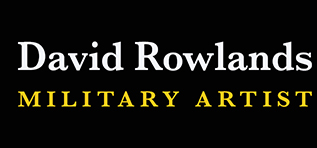« Click on Picture to
Return »
 |
|
Operation OVERLORD. D-Day
6th June 1944: 9th (Irish) Field Battery firing on the 'Run-in Shoot' to Queen Beach.
When I was asked to do a painting of self-propelled howitzers being transported across the English Channel in a Landing Craft (Tank) on D-Day, I was astonished to learn that they actually fired over the heads of the smaller Landing Craft towards the German defences. In the pitch-and-toss of the heavy sea, I wondered what degree of accuracy their shooting might achieve at a range of 10,000 yards. Fire for effect commenced at 06.55 hrs and went on until 07.40 hrs. I was told they were the first rounds fired at the Normandy coast.
9th (Irish) Field Battery was part of 7th Field Regiment Royal Artillery, and I was provided with a copy of the relevant pages of its War Diary.
An M7 105 mm Self-Propelled Howitzer was called a 'Priest' in British service (because of the pulpit-like mounting for the 0.5-in. machine gun). Besides looking at wartime photographs of the Priest on service in Normandy, I went to see an original example in the Museum of Artillery at the Rotunda, Woolwich.
Colonel Paddy de Burgh at the Badley Library of the Royal School of Artillery helped with the guns. The staff at The National Maritime Museum provided me with detailed technical drawings of an LCT and showed me a large scale model in their stores.
I went to the London home of General Sir Nigel Tapp DSO, who had commanded the Regiment in 1944. He described the scene that morning of 6th June, as the sky and sea lightened. I drew sketches imagining the scene from various angles, trying to achieve the best viewpoint to portray the guns, the LCT and the Eastern sky, with the distant Landing Craft approaching the beaches.
Arthur Harper, a Gun Position Officer in the battery in 1944, explained to me the gun drill and the appearance of the ammunition, and drew for me the formation signs worn on the men's sleeves. Major Hendrie Bruce, a Forward Observation Officer of the Battery, described how two Priests were positioned side-by-side, with a Sherman tank in front of them. He told me that A Troop was embarked on LCT 331. The guns were named after battles in which the battery had fought, and 'A' sub-section, the nearest gun, was named 'Arras'. The anti-aircraft machine guns were uncovered, and ready for action. Dick Gregory gave me details about his O.P. Sherman tank. The B Troop leader, Capt. W Hugh Green sent me many notes on the subject. Derek Findlay and George Turney (both Lieutenants in 9th Battery on D-Day) wrote letters giving useful details, including the wind direction (South West, force 3-4). As the LCT was proceeding southwards this helpfully avoids the subject of my painting being shrouded in gun smoke!
Medium: Oil on Canvas
Printed image size(s): B2 only (58 x 38 cm)
Owner: 24 (Irish) Battery Royal Artillery
Price(s): £75
|
|



